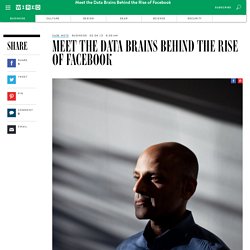

This Mathematician Says Big Data Is Causing a ‘Silent Financial Crisis’ Roads to Rome. How-to-become-a-data-scientist.jpg (JPEG Image, 1280 × 5859 pixels) - Scaled (17%) How to Catch a Terrorist. Almost every major terrorist attack on Western soil in the past fifteen years has been committed by people who were already known to law enforcement.

One of the gunmen in the attack on Charlie Hebdo, in Paris, had been sent to prison for recruiting jihadist fighters. The other had reportedly studied in Yemen with Umar Farouk Abdulmutallab, the underwear bomber, who was arrested and interrogated by the F.B.I. in 2009. The leader of the 7/7 London suicide bombings, in 2005, had been observed by British intelligence meeting with a suspected terrorist, though MI5 later said that the bombers were “not on our radar.”
The men who planned the Mumbai attacks, in 2008, were under electronic surveillance by the United States, the United Kingdom, and India, and one had been an informant for the Drug Enforcement Administration. One of the brothers accused of bombing the Boston Marathon was the subject of an F.B.I. threat assessment and a warning from Russian intelligence. Big Data Is Transforming Healthcare. Photo: Ariel Zambelich/Wired NEW YORK CITY — Big Data is all around us.

It’s in the way we shop, do our finances, and tweet. What does Big Data even mean, you ask? To some, it’s more information than your laptop can handle. Others define it as melding data from different sources and seeing what patterns emerge. “I’m a photographer, so that [explanation] didn’t mean much to me,” said Rick Smolan Oct. 15 here at the inaugural Wired Health Conference in New York. Then the Against All Odds Productions CEO ran into Yahoo chief Marissa Mayer. And that nervous system of data is developing at tremendous rates thanks to growth factors like social media, gadgets that record how much electricity each appliance in your house eats up, consumer genomics, and personal trackers like Fitbit, Zeo or the Nike fuel bracelet (a favorite among Wired staff, according to executive editor Thomas Goetz). “The challenge is … how do you make it something [people] care about?” The Personal Analytics of My Life.
March 8, 2012 One day I’m sure everyone will routinely collect all sorts of data about themselves.

But because I’ve been interested in data for a very long time, I started doing this long ago. I actually assumed lots of other people were doing it too, but apparently they were not. And so now I have what is probably one of the world’s largest collections of personal data. Every day—in an effort at “self awareness”—I have automated systems send me a few emails about the day before. Let’s start off talking about email. Blogging about big data, visualization and new market research. Stats : Jan 2013 Summary. Meet the Data Brains Behind the Rise of Facebook. Jay Parikh sits at a desk inside Building 16 at Facebook’s headquarters in Menlo Park, California, and his administrative assistant, Genie Samuel, sits next to him.

Every so often, Parikh will hear her giggle, and that means she just tagged him in some sort of semi-embarrassing photo uploaded to, yes, Facebook. Typically, her giggle is immediately followed by a notification on his Facebook page. If it’s not, he has some work to do. Parikh is Facebook’s vice president of infrastructure engineering. He oversees the hardware and software that underpins the world’s most popular social network, and if that notification doesn’t appear within seconds, it’s his job to find out why.
The trouble is that the Facebook infrastructure now spans four data centers in four separate parts of the world, tens of thousands of computer servers, and more software tools than you could list without taking a deep breath in the middle of it all. But that’s why Parikh and his team build tools like Scuba. Big data: Why it's really an architecture challenge. What's missing from all the conversations about big data is a focus on the infrastructure necessary to support it — and in particular its use in real time.

For many companies, big data means opening up access to the data warehouses they have always maintained. Data warehousing has been and continues to be a critical component of enterprise-class organisations. Such systems provide the aggregation of data from across the organisation and enable it to be sliced and diced into consumable chunks allowing business analysts to provide insights into business conditions.